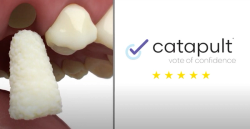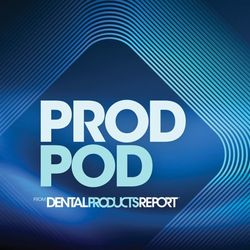- About Us
- Advertise
- Editorial
- Contact Us
- Terms and Conditions
- Privacy Policy
- Do Not Sell My Personal Information
© 2025 MJH Life Sciences™ and Dental Products Report. All rights reserved.
Working at a distance
A 55-year-old gentleman sought a smile make-over and a full reconstruction of his dentition. The case was somewhat unique for me in that the clinician was working in Florida, and the case would be completed nearly 1,500 miles away at my lab in Illinois. This, of course, meant there was no way for the patient to meet with me for a personal visit to verify shade, fit, incisal edge positioning, contour or shape in the final restoration.
A 55-year-old gentleman sought a smile make-over and a full reconstruction of his dentition. The case was somewhat unique for me in that the clinician was working in Florida, and the case would be completed nearly 1,500 miles away at my lab in Illinois.
This, of course, meant there was no way for the patient to meet with me for a personal visit to verify shade, fit, incisal edge positioning, contour or shape in the final restoration.
Anytime we receive a case as complex as this one was-involving a totally edentulous patient-it is challenging to complete. Trying to do this on a long-distance basis presents even more difficulty. How can we better communicate our lab procedures with predictability in the final outcome?
With a case such as this, it was essential that the relationship between the clinician and the lab be one of trust to present a final case outcome that met or exceeded expectations. The clinician sent many patient images via email to accurately describe the patient’s pre-operative appearance. Some of the things that needed to be discussed were types of implants being used and material selection, as well as the size of the teeth and how to create a natural look with pink porcelain for the gum area.
This article’s focus will briefly illustrate the approach the dental team took for this case.
Case Study
In Figure A the impression copings are shown in place before the impression was taken. The maxillary view indicates the implant platform and the way it appeared in the operatory setting. Due to the necessary sizing of the implants, different systems were used (Fig. B).
01 After pouring up the models with the soft tissue, it was possible to better see the implant angulation and positioning (Fig. C).
02 With the temporaries in place, (Fig. D) I noted the shape of the teeth (square, square) and the size of the lateral, tooth No. 10-slightly longer than the other, with some staining and a long-term guideline from the lip to the incisal height of the smile line.
03 Using the 3Shape scanner to capture the case, the data was sent to the GC Advanced Technologies Milling Center, which fabricated 6 titanium implant abutments (Fig. E). The number of teeth involved and direction of implant fit is depicted in this image.
04 The substructure to fit the implant abutments were then waxed, cast and polished to a finish (Fig. F). An appropriate amount of wax was needed for proper contouring to protect the teeth from possible fracture. The metal substructure left an appropriate amount of room for the porcelain build-up (Fig. G).
05 The anterior design had an open embrasure in the cervical area due to the metal substructure’s precision fit (Fig. H). The abutments had good angulation and path of draw as demonstrated on the model (Fig. I).
06 The third build-up was finalized and contoured, especially at the gum line. GC Initial MC Porcelain was used for the porcelain work on this case (Fig. J).
07 Porcelain was overlaid with enamel 59 on top of the pink gum color (Fig. K).
08 Right quadrant (Tooth Nos. 2, 3, 4 and 5) porcelain work is shown on the model (Fig. L) with the left side next (Fig. M).
09 A mirrored image with the six unit bridge and abutments displayed gives the technician a chance to check esthetics (Fig. N).
10 The finished bridge is checked on the cast model before shipping to the clinician for case seating (Fig. O).
Conclusion
Our guideline for the incisal positioning was the temporary model and the temporary putty on the metal frame design. Two centric bites and one protrusion bite were sent with the metal framework for try-in to verify occlusion in the clinical setting.
If the bite could not be verified in this manner, the mounting would have to be adjusted at the laboratory. Everything my lab technicians and I used to verify bite was based on the study models and the horizontal and vertical measurements taken from the articulation mounting.
Once the bite was verified in this manner, we were able to begin the porcelain build-up. Without all these communication tools and photo images, it would have been very difficult to get the esthetics. The clinician and the laboratory must be speaking the same language at all times.
When it came time to fabricate the restorations, we had to use our skills to create facial contour anatomy in comparison to the study models. The patient had been wearing his provisionals for six months and it would be difficult for him to change. His perception and expectations had become based on the temporary teeth, which could make the new bite feel somewhat uncomfortable at first.
With a long span bridge of this nature, there is discrepancy in the patient’s mind when we must change the incisal edge position as well as the texture and contour of the teeth position. A slight overlap best mimics nature, which is the appearance the team was seeking.
Often, budgetary issues will stop the patient from being able to complete the case in the best possible manner, but the team took the described approach and were able to fabricate a restoration that met his needs. The final result was considered to be a tremendous improvement over what the patient had been wearing.



